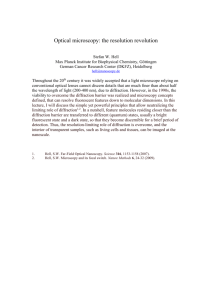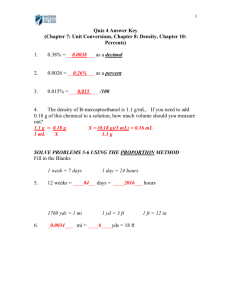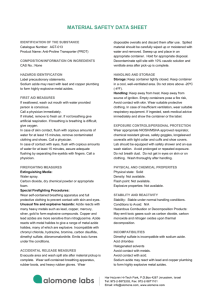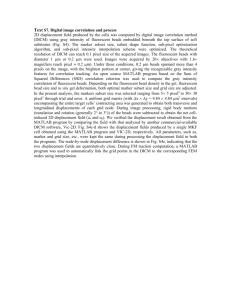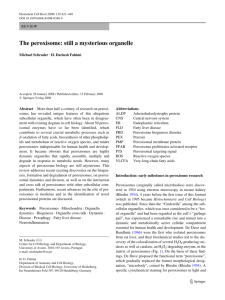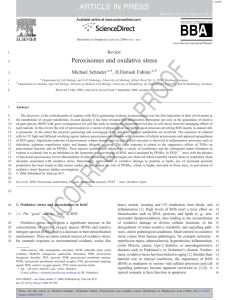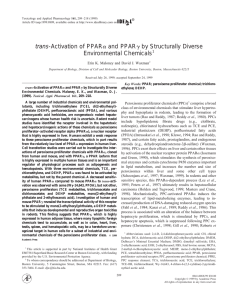Fig. R3 The width σ conv of a Gaussian fluorescent object of true
advertisement
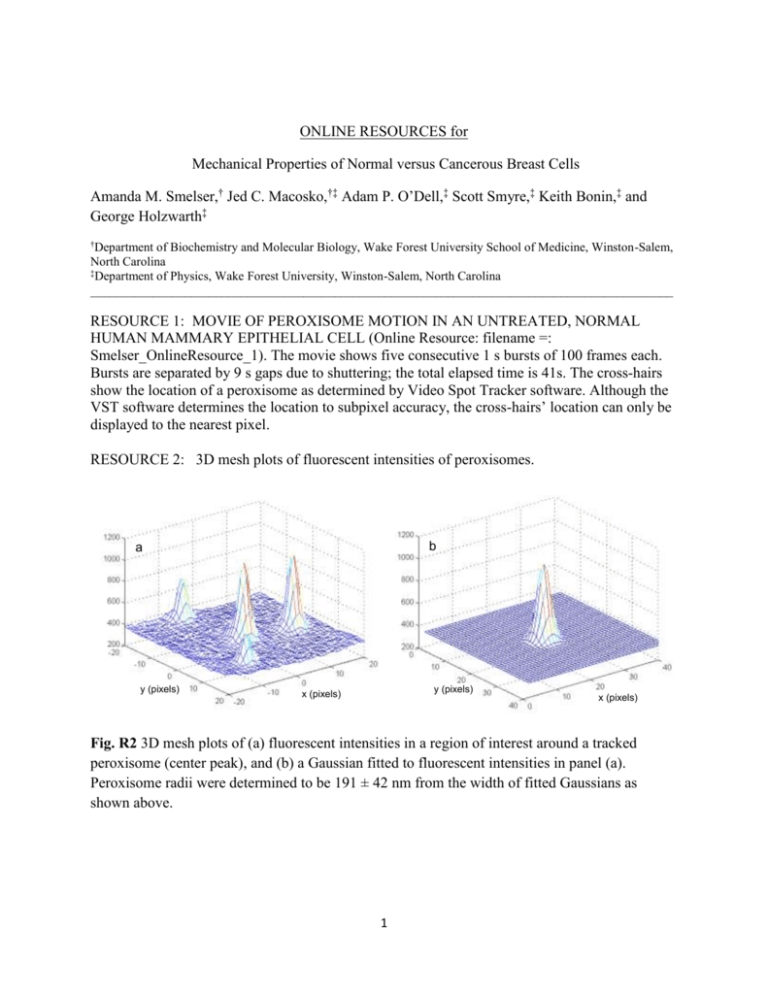
ONLINE RESOURCES for Mechanical Properties of Normal versus Cancerous Breast Cells Amanda M. Smelser,† Jed C. Macosko,†‡ Adam P. O’Dell,‡ Scott Smyre,‡ Keith Bonin,‡ and George Holzwarth‡ † Department of Biochemistry and Molecular Biology, Wake Forest University School of Medicine, Winston-Salem, North Carolina ‡ Department of Physics, Wake Forest University, Winston-Salem, North Carolina _____________________________________________________________________________________________ RESOURCE 1: MOVIE OF PEROXISOME MOTION IN AN UNTREATED, NORMAL HUMAN MAMMARY EPITHELIAL CELL (Online Resource: filename =: Smelser_OnlineResource_1). The movie shows five consecutive 1 s bursts of 100 frames each. Bursts are separated by 9 s gaps due to shuttering; the total elapsed time is 41s. The cross-hairs show the location of a peroxisome as determined by Video Spot Tracker software. Although the VST software determines the location to subpixel accuracy, the cross-hairs’ location can only be displayed to the nearest pixel. RESOURCE 2: 3D mesh plots of fluorescent intensities of peroxisomes. b a y (pixels) y (pixels) x (pixels) x (pixels) Fig. R2 3D mesh plots of (a) fluorescent intensities in a region of interest around a tracked peroxisome (center peak), and (b) a Gaussian fitted to fluorescent intensities in panel (a). Peroxisome radii were determined to be 191 ± 42 nm from the width of fitted Gaussians as shown above. 1 RESOURCE 3: The effect of the Point Spread Function (PSF) on the determination of peroxisome radius Diffraction causes a systematic error when a microscope is used to determine particle size. Because of diffraction, the image of a point object in the microscope is an Airy disk, not a point. because of diffraction. The Airy disk has a strong central lobe surrounded by low intensity rings. The intensity in the central lobe is well approximated by a Gaussian. The width of the Gaussian is given by: 1 𝜎𝑝𝑠𝑓 = 𝑛𝑘 𝑒𝑚 ⌈ 1/2 3 7 4−7𝑐𝑜𝑠 ⁄2 +3𝑐𝑜𝑠 ⁄2 3 7(1−𝑐𝑜𝑠 ⁄2 ) ⌉ ≈ 0.22 𝜆𝑒𝑚 𝑁𝐴 where kem = 2πn/λem, , λem is the wavelength of the emitted light, n is the refractive index of the medium in contact with the microscope objective, is the maximal convergence semiangle of the objective ( α = sin-1(NA/n)), and NA is the numerical aperture of the objective (Zhang et al (2007)). Inserting λem= 0.509 m as the emission wavelength of GFP, NA = 1.4 for our Nikon 60x objective, and n = 1.51 for the refractive index of the oil used with our objective, one obtains σpsf = 0.080 μm. For epifluorescence imaging with a wide-field microscope and CCD camera, the size of the error is determined by the PSF of the microscope objective and by the pixel size of the camera. We will assume that the pixels are small enough to digitize the PSF without degradation. The images of small objects such as peroxisomes and beads are also broadened by diffraction. The broadened particle image is the convolution of the PSF with the true particle image. If the PSF, the observed image, and the true image are all approximated by Gaussians, the variance of the convolved image is the sum of the variances of the PSF and the true image. The width of each Gaussian is then the square root of the respective variance. Calling the width of the true image σ0, the width of the convolved image σconv was evaluated for 0.023 ≤ σ0 ≤ 0.60 μm while keeping σpsf = 0.080 μm. The broadening effects of diffraction are shown in Fig R3. The figure shows that diffraction has a relatively small effect on particles of radius 0.15 m or greater. 2 Fig. R3 The width σconv of a Gaussian fluorescent object of true width σ0 after broadening by a PSF of width 0.080 µm. The width of the broadened Gaussian is given by the heavy line. The straight diagonal dashed line is a reference line for σconv when there is no diffraction. Blue circles ( ) mark the measured width of fluorescent polystyrene beads of known radius R. The red square (■) marks the measured mean radius of the peroxisomes. Error bars are ± one standard deviation. In several cases for bead data, the error bars fall within the symbols. Figure R3 shows that the measured radius of peroxisomes, 0.191 ± 0.042 μm, falls above the PSF and into the zone where beads can be sized. If the measured peroxisome radius was corrected for PSF effects using Fig R3, the mean peroxisome radius would be reduced to 0.179 μm, a change of 7%. Peroxisome radii were not corrected for this effect because the change was small. We have tested whether our microscope/camera system could distinguish between fluorescent beads of diameter 0.2, 0.4, 0.5, and 1 m. The results are also shown in Fig R3. The measured Gaussian widths are approximately as predicted by the theory. 3 RESOURCE 4: Demonstration that the tracking of beads undergoing Brownian motion in water, followed by GSE analysis, leads to the correct (Handbook) viscoelastic modulus of water. 101 Xanthan (2 mg/mL) Water (Experimental) G* (Pa) 100 Water (Handbook) 10-1 10-2 10-3 10-4 10-1 100 101 ω (rad/s) 102 103 Fig. R4 Experimentally determined viscoelastic modulus of water (long dash, filled diamonds) and 2 mg/mL xanthan (short dash, open diamonds) compared to expected viscoelastic moduli of water as determined from the CRC Handbook (solid red line)(1). Fluorescent polystyrene beads (diameter = 0.40 μm) were suspended in 80 mM PIPES with 7.8% KCl, or 2 mg/mL xanthan in 80 mM PIPES with 7.8% KCl, and imaged at 100 fps in a microfluidic chamber with inner dimensions x, y, z = 8 mm, 18 mm, 70 μm. ____________________________________________________________________________ 4 RESOURCE 5: Bihistograms of the MSDs of normal, tumorigenic, and metastatic cells. Fig. R5 Bihistograms of the MSDs of normal, tumorigenic and metastatic cells in 8 mM sodium azide + 50 mM 2-deoxy-D-glucose (τ = 20 s). The observed histograms are not normally distributed, nor is a normal distribution expected (Grebenkov, 2011). The expected distribution function also differs from a log-normal function. Because the histograms are not normally distributed, the usual Student’s t-test for significant differences between distributions cannot be applied. Non-parametric rank-based tests, such as Mann-Whitney, have been developed to address this problem. 5 RESOURCE 6: Diagram showing the relative sizes of peroxisome tracks, peroxisomes, and noise. Control Low azide High azide Noise Peroxisome (Approx. Size) 1 μm Step size (τ) = 10 s, total path duration = 90 s Fig. R6 Tracks of single peroxisomes in normal human mammary epithelial cells incubated in MEGM, MEGM with low azide (2 mM sodium azide + 2 mM 2-deoxy-D-glucose) or MEGM with high azide (8 mM sodium azide + 50 mM 2-deoxy-D-glucose). Tracks with MSDs within 10% of the average peroxisome MSD for each condition (control, low azide, high azide) were chosen to be representative for that condition. The “noise” track was determined by imaging the motion of 0.40 μm fluorescent polystyrene beads adhered to the bottom of a dish. Each vertex in the path represents the location of the particle 10 s after the previous location was determined, and the total path duration is 90 s. The average peroxisome size relative to these tracks is shown in the bottom right hand corner. SUPPORTING REFERENCES 1. Lemmon EW Thermophysical Properties of Water and Steam. In: Haynes WM (ed) Handb. Chem. Phys. Online, 94th edn. Taylor and Francis, pp 6–1. Web. 29 April 2014. www.hbcpnetbase.com. 2. Grebenkov D (2011) Probability distribution of the time-averaged mean-square displacement of a Gaussian Process. Phys Rev E84: 0031124. 3. Zhang B, Zerubia J, Olivo-Marin J-C (2007) Gaussian approximations of fluorescence microscope point-spread function models. Appl Opt 46:1819–1829. 6



